|
'Old Rocketeer' Harry Stein, who authored the monthly "Rocket Trails"
column in American Modeler magazine for many years, presents
here a simple treatment of the technicalities of model rocket engines
such as those produced by
Estes, Centauri, and Model Missiles (of
those, only Estes still makes motors), but
Quest and
Aerotech are other modern model rocket motor suppliers. Specific
impulse, thrust, burn time, motor sizes, delay times, and ejection
charges, etc. are all covered.
Rocket Trails: Basic Info on Propulsion Systems for Small "Birds"
by Harry (Old Rocketeer) Stine
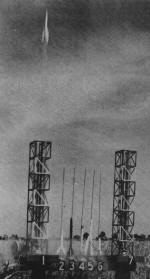 The
gizmo that makes model rocketry a hobby instead of a debacle is
our model rocket engine, that simple-looking inexpensive package
of power that comes ready to install in the tail of your latest
bird. Us mod-roc-nuts have been using these paper tubes full of
zip-stuff for five years, often with little knowledge as to what
makes 'em tick. Things have changed, however. The National Association
of Rocketry has released a set of reports giving all the poop on
NAR-certified engines, including thrust-time curves. The
gizmo that makes model rocketry a hobby instead of a debacle is
our model rocket engine, that simple-looking inexpensive package
of power that comes ready to install in the tail of your latest
bird. Us mod-roc-nuts have been using these paper tubes full of
zip-stuff for five years, often with little knowledge as to what
makes 'em tick. Things have changed, however. The National Association
of Rocketry has released a set of reports giving all the poop on
NAR-certified engines, including thrust-time curves.
First Things First. To avoid any confusion let's define the terms
used in talking about model rocket engines.
Thrust is the amount of force or "push" produced by an operating
engine. It's measured in ounces for little engines, pounds for big
ones. The jet blast of high speed gas coming out of the aft end
of the engine produces this thrust, or so sez Sir Isaac Newton.
The thrust of an engine can change, by the way. So you can speak
of max thrust as the highest amount of push given. Or you can talk
average thrust - but let's wait a bit before tackling that one.
The length of time that thrust is produced is called duration.
It's measured in seconds. Two seconds is a very long duration for
a model rocket engine. In engines where thrust varies, the time
from ignition to max thrust is called T-max.
To accurately determine thrust, max thrust, duration, T-max,
and other operating parameters, we gotta conduct static tests. An
engine is fastened down with recording instruments attached to it
... and it's fired. With luck, everything works and the instruments
give data unless some idiot forgets to start the recording gadget.
Data recorded from most static tests is a record of thrust as a
function of time. This is called the thrust-time curve. It's a chart
of the thrust during every instant of operation. Believe me, with
most engines it takes quite a stack of gear to record this! It ain't
easy, although Irving Wait of Rocket Development Corp. in Utah is
going to bring out a recording-type static test stand for sale to
model rocketeers.
If we take a thrust-time curve and calculate the area under the
curve by laying a sheet of quadruled paper over it and counting
the squares (or using a polar planimeter as I do), you get something
known as the total impulse - pounds times seconds, or simply pound-seconds.
If a rocket engine had steady thrust from the instant of ignition
until the instant of burnout, you could get the total impulse by
multiplying the thrust by the duration. Unhappily, no engine has
this kind of simple thrust-time curve.
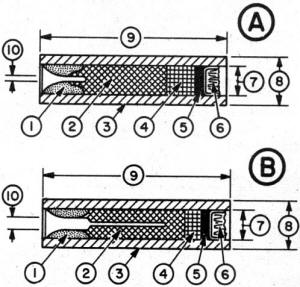
Cross-sections above are (A) Estes' Series 1
Type B. 8-4 and (B) Estes' Series 2 Type B3-5 rocket engines. Key:
1) Nozzle; 2) Propellant; 3) Paper Casing; 4) Delay Charge; 5) Ejection
Charge; 6) Retainer Cap; 7) 0.406"; 8) 0.690"; 9) 2.75"; 10) 0.107"
for "A" and 0.1875" for "B".
The physics book definition of total impulse sez it is the change
in total momentum of a rocket produced by the operation of the engine.
Momentum is mass times velocity. For a model of given weight, an
engine of higher total impulse will produce a higher speed at burnout,
thereby giving a higher peak altitude. Several issues ago, I said
that thrust is only part of the story. This is why. Total impulse
is the thing to think about. Which is why the NAR rates engines
in classes based on total impulse.
Average thrust is always a computed value determined by dividing
the total impulse by the duration. It gives you a figure that tells
what the thrust of an engine would be if it were steady from ignition
to burnout. Unless you know calculus, average thrust is what you
have to use in figuring rocket performance.
After this 60-second background in rocket engine theory, let's
look at some data.
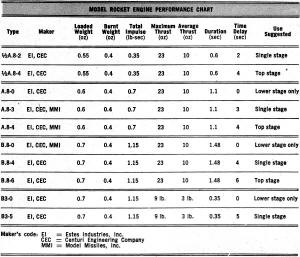
Model Rocket Engine Performance Chart
Engine Line-up. All of the NAR Type Half-A, Type A, and Type
B engines sold by Centuri Engineering, Estes Industries, and Model
Missiles are almost identical in size, weight, total impulse, and
performance. The performances of the various engines of the "point-8"
series is shown. Note that the only significant difference between
them is the duration and total impulse. A cutaway of a typical Type
B engine is also shown. On all of these engines, thrust rises rapidly
to 23 ounces about 0.180 seconds after ignition; this helps kick
the model off the launcher and into the air fast so that its stabilizing
fins will work. Thereafter, thrust settles down at about 10 ounces
for accelerating the model in the air.
The tables shows the duration, total impulse, and weights of
these various engines. Estes has all of them, so does Centuri Engineering.
Model Missiles sells Type A.8-3 as Standard A-4, Type B.8-4 as Super
B-6, B.8-0 as Lower Stage, and Type A.8-4 as Upper Stage.
These engine type numbers shouldn't scare you. They are in a standard
code developed by the NAR and used by most engine manufacturers.
Knowing the code will tell you a great deal about an engine. The
first letter indicates total impulse range as follows:
Type Half-A = 0 to 0.35 lb-sec.
Type A = 0.35 to 0.7 lb-sec.
Type B = 0.701 to 1.20 lb-sec.
The first letter indicates the average thrust in pounds or fractions
of pounds. The number following the dash tells you the number of
seconds of time delay built into the engine before it pops the chute
or recovery device.
All of the engines we've discussed are pretty much alike. Looking
at the cross section, you can see that there is a slight indentation
in the propellant grain next to the nozzle; this provides a little
extra burning area right at the start and results in the high initial
peak thrust. Following this, the propellant burns in a forward direction
like a cigarette. When it's all gone, it lights off the time delay
charge, which is a very slow burning propellant producing no thrust
at all and giving the model time to coast upward on the momentum
it's gotten during the powered portion of flight. Finally, the time
delay burns through and ignites the ejection charge which produces
a quick burst of gas pressure. This can be made to do mucho different
things such as kick out a chute, slam the engine back, eject the
engine, pop off the nose cone, and etc.
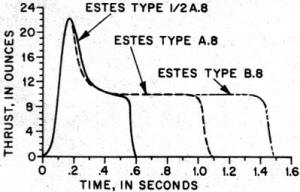
About a year ago, Estes introduced a new engine, now called the
B3. It's exactly the same size as other type B engines. But what
a difference in performance! Look at its cutaway diagram. There
is a hole in the propellant charge. This gives more burning surface
area, hence higher thrust. I had a terrible time trying to get test
data on the B3 engines; took me a year to figure out how. When you
look at the thrust-time curve, you'll see why. The Type B3 engine
is a sledgehammer, a boot in the tail, an impulse engine. It burns
for about 0.3 seconds and produces a maximum thrust of nine pounds!
This will give a one-ounce model rocket an acceleration of about
143 gees! Ka-whoom, and it's up there. You don't even see it leave
the launcher.
Estes and Centuri both sell the B3 engine now, and it comes in
two styles:
B3-5 for single staged models, and B3-0 for lower stage boosting.
Because the total impulse of the B3 engine is 1.1 pound-seconds,
it doesn't heave a model any higher than a Type B.8-6 engine. In
fact, it doesn't take it as high because burnout is lower with the
B3 engine. It hits burn-out just a few feet off the launcher.
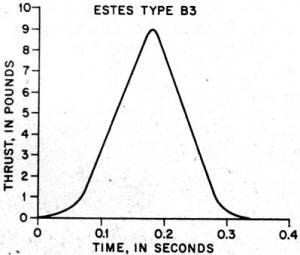
The B3 is a terrific engine for drag racing and for acceleration
studies with single-staged models. For staged models, the B3-0 is
the answer to a rocket-made maiden's prayer because it will boost
a heavy three-stage model off the launcher in One Big Hurry so that
the bird gets airspeed quickly and doesn't wallow around. For years
I sweated to get a successful 3-stage model with only three engines.
Now that the B3 is available for boosting, I've watched 13-year-old
Steve Lewis of Norwalk, Conn. fly his 3-engined 3-stager several
times in a row, perfectly straight up to better than 1500 feet on
each shot. Undoubtedly, other guys have done it, too, but I mention
this one because I vas dere, Charlie.
Tests of the Coaster Type F engines are nearing completion, and
new Centuri Mini-Max engines are coming right along in development.
Next Month: More about boost gliders, the USAF meet, other mad
ramblings. If you characters will write in with some good questions,
I will stroke my long white beard and answer them. For data on NAR,
or if you want to tell me what you think, drop me a post card care
of this magazine. Ye Kindly Olde Editor, bless his propeller-flicking
finger, will see to it that I get 'em.
And, honest, fellas, while my house does have a white front door,
there's no hole in the roof!
Posted May 23, 2015
|